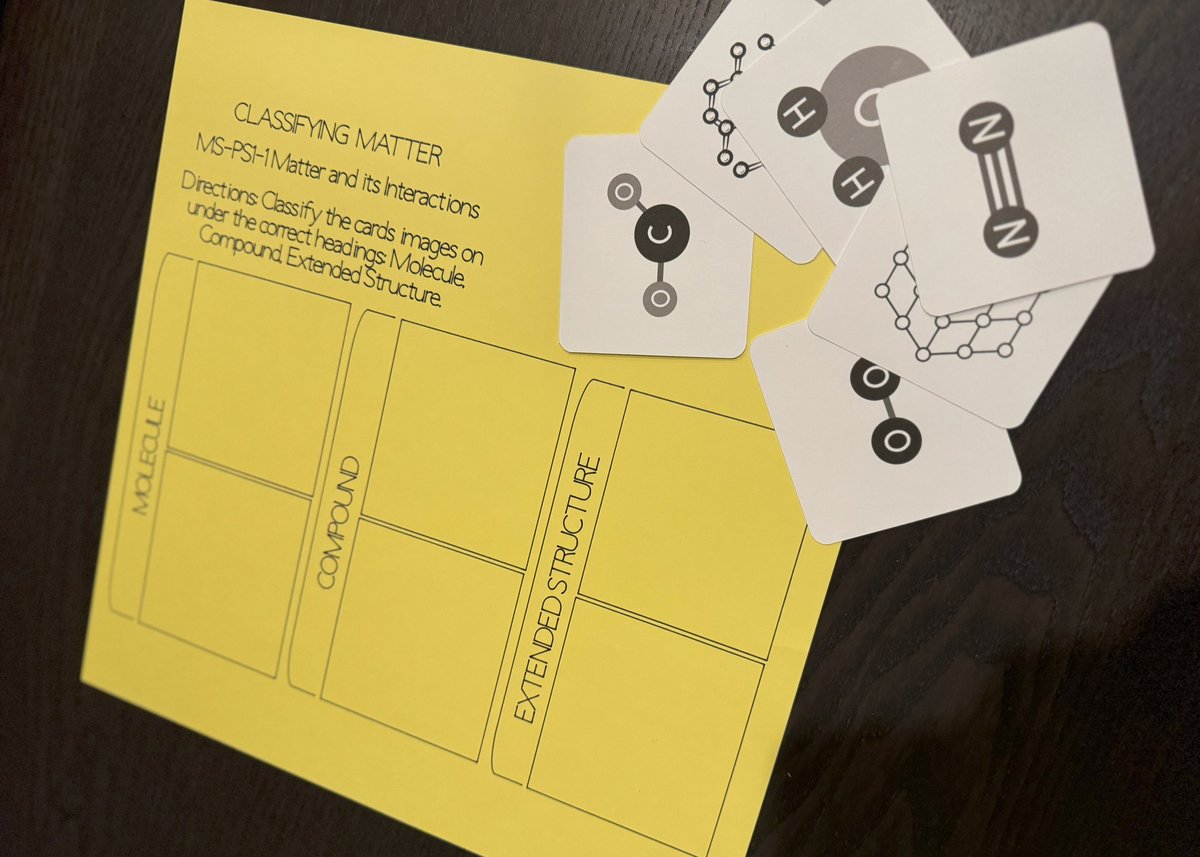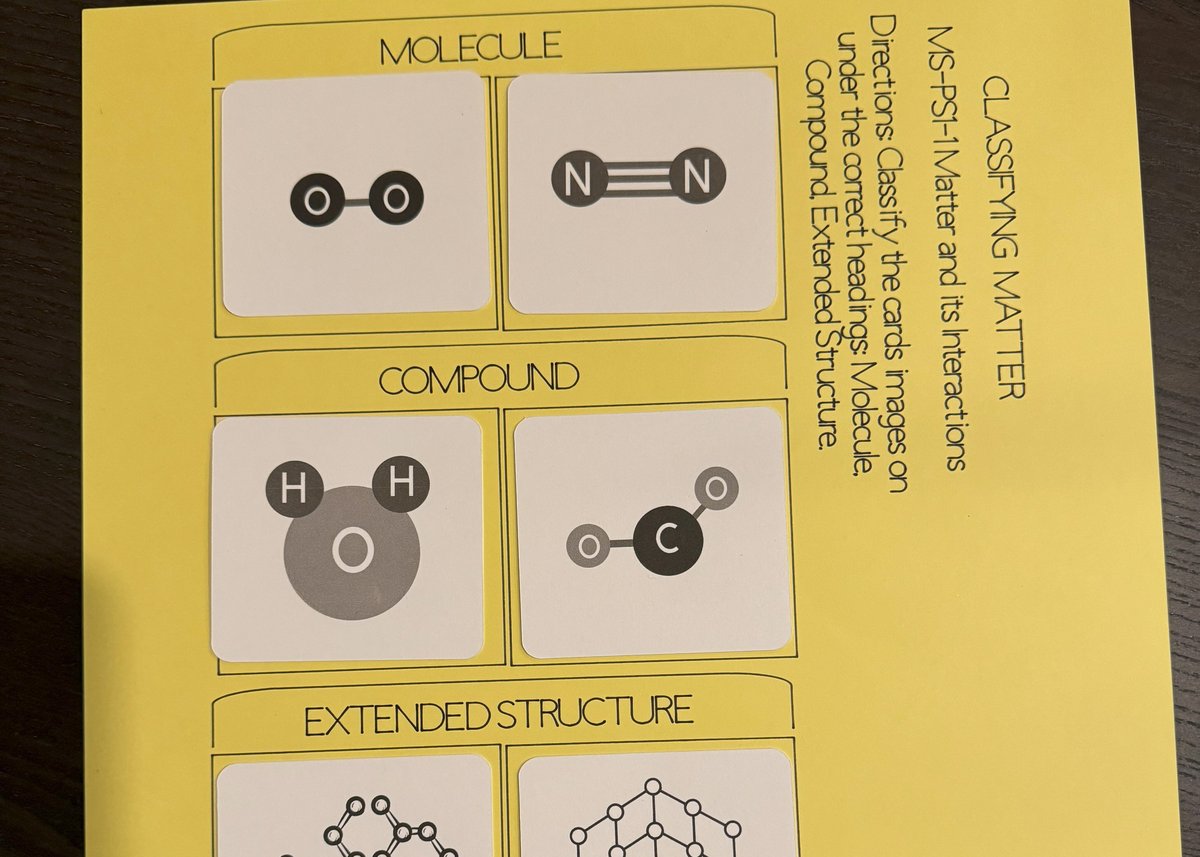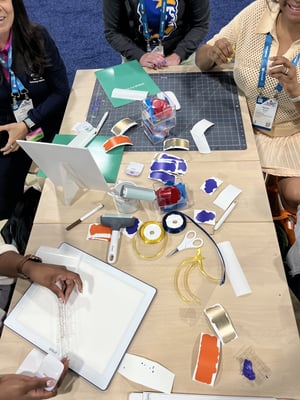Classifying Matter Matching Activity



Description of Cricut Lesson & Activity
Using Cricut, this lesson offers a hands-on experience to help students classify types of matter. The teacher designs and cuts placemats and classification cards, customizing to the needs of the learner. Students engage in hands on activity by classifying images and discussing their reasoning, enhancing their understanding of molecules, compounds, and extended structures.
- Science
ISTE Standards
- 1.1 Empowered Learner
1.1a Learning Goals
1.1c Feedback to Improve Practice - 1.3 Knowledge Construction
1.3.b Evaluate Information
State / Local / Other Standards
MS-PS1-1. Develop models to describe the atomic composition of simple molecules and extended
structures.

For full project details, open in Cricut Design Space.
Click Here
For full project details, open in Cricut Design Space.
Click Here
Click Here
For use in your classroom, download full lesson plan.
Download Here

For full assessment rubric, download here.
Download Here
Learning Objective(s)
- Students will be able to classify images of substances as molecules, compounds, or extended structures.
Materials Required
- Cricut machine
- Cricut Design Space software
- Cricut mat
- Cricut pen (0.4 Tip, Black)
- Cardstock paper (12" x 12")
- Markers or colored pencils
- Interactive whiteboard or projector
- Science notebooks
- Exit tickets
Instructions
Preparation:
- Use the Cricut Design Space software to create a placemat template for classification
with sections for molecules, compounds, and extended structures or use the following
template with the Cricut draw feature. - Design cards with images of various molecules, compounds, and extended structures or
use the following template. - Use the Cricut print-then-cut feature to print and cut out the image cards.
Lesson Breakdown:
Introduction (10 minutes)
1. Engage:
- Begin with a brief discussion on what matter is and its different forms.
- Show an image of a simple molecule (e.g., water), a compound (e.g., sodium
chloride), and an extended structure (e.g., diamond). - Ask students to share what they know about each and how they might be
different or similar.
2. Objective:
- Explain that today’s lesson will focus on classifying images of different types of
matter into categories: molecules, compounds, and extended structures.
Instruction (15 minutes)
3. Direct Instruction:
- Use a presentation to define and give examples of molecules, compounds, and
extended structures. - Molecule: A group of atoms bonded together, representing the smallest
fundamental unit of a chemical compound that can take part in a
chemical reaction. - Compound: A substance made of two or more different types of atoms bonded together.
- Extended Structure: A large, often repeating pattern of atoms or molecules, such as crystals or polymers.
- Show images and provide a brief explanation for each type.
4. Guided Practice:
- Display a few images and classify them together as a class. Use think-pair-share for students to discuss their classifications before sharing out.
Activity (25 minutes)
5. Independent Practice:
- Distribute the Cricut-created placemat templates and sets of image cards to each student or group of students.
- Students will classify the images on the placemats under the correct headings: Molecule, Compound, Extended Structure.
- Encourage students to write a brief justification for each classification in their science notebooks.
Monitoring:
- Walk around the room, observing students' classifications, and providing guidance or prompting questions as needed.
- Assess student learning with rubric criteria.
Closure (10 minutes)
7. Review and Reflect:
- Have students share their classifications and justifications with the class.
- Correct any misunderstandings and reinforce the characteristics of molecules,
compounds, and extended structures.
8. Exit Ticket:
- Ask students to write down one thing they learned about classifying matter and
one question they still have.
Cricut Integration:
1. Designing the Placemat:
- Use Cricut Design Space to create a placemat template divided into three sections: Molecule, Compound, Extended Structure.
- Add labels and decorative elements to make the placemat visually appealing.
2. Printing and Cutting the Cards:
- Design cards with images of various molecules, compounds, and extended
structures in Cricut Design Space. - Use the print-then-cut feature to print the images onto cardstock and then cut them out using the Cricut machine.
- Ensure each card is accurately cut and easy for students to handle and place on the placemat.
3. Execution:
- Before the lesson, prepare enough placemats and sets of cards for all groups or students.
- Demonstrate how to use the placemat and cards for classification during the
guided practice. - Optional, laminate for reuse and durability. By incorporating the Cricut machine, students will have hands-on, engaging materials to work with, enhancing their understanding and making the lesson more interactive.
Assessment
- Formative assessment through observation and exit tickets.
- Summative assessment based on the accuracy of placemat classifications and justifications.
Differentiation:
- Provide additional scaffolding and support for students who need it.
- Offer more complex examples for advanced learners to classify.
